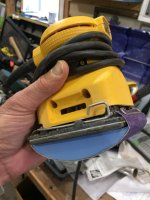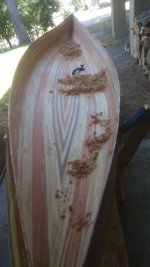-
Happy Birthday, Beethoven (1770-1827)! 🎼 5️⃣ , 9️⃣
You are using an out of date browser. It may not display this or other websites correctly.
You should upgrade or use an alternative browser.
You should upgrade or use an alternative browser.
sanding insanity
- Thread starter Trevor27
- Start date
Make sure your sander is hooked up to a vacuum....that helps a lot. Rotate the hull as much as possible. Put wireless ear buds in, cover them with ear muffs, listen to Death Metal.
Finally, drink'n helps. Stick to light beer though, the hard stuff will make you light the thing on fire.
Finally, drink'n helps. Stick to light beer though, the hard stuff will make you light the thing on fire.
I usually start with a scorp, nice and sharp. That cuts all the high spots quickly.
I feel your pain.
Jim
I feel your pain.
Jim
Absolutely no fun !
Mem has it ! Hook up to a dust collector , it will make your paper last longer, and keep debris, out of the hull.
I use a variable speed ROS. I do not like a soft pad, as it tends to sand the soft wood, and not the glue.
Bosch makes one at a reasonable price ! I've used one for years . I even have a back up, still in the box.
Jim
Mem has it ! Hook up to a dust collector , it will make your paper last longer, and keep debris, out of the hull.
I use a variable speed ROS. I do not like a soft pad, as it tends to sand the soft wood, and not the glue.
Bosch makes one at a reasonable price ! I've used one for years . I even have a back up, still in the box.
Jim
I prefer a pneumatic ROS and jitterbug style sander. Quieter and easier for me to control the speed on the fly as I sand. I also have found an air file type sander works well on fairing the flatter sections. It could be that I am just more proficient having used them for 30 years sanding car panels. The large compressor is in another building though. The noise of a small one running constantly next to me would drive me bonkers.
Bob
Bob
Bob ! Lucky you !
I would love to have such a set up. Better yet, some one with your experience, and equipment to do my sanding !
Most first time builders don't have such. I've been building 30+ years, and I still don't have the equipment.
I had a hull once ready for varnish, so I thought. went to a local Auto Body shop, and asked what they would charge to spray said hull. The guy came out and in one look, said It needed more sanding. I said OK. Do it.
He only charged me $50 to sand and spray a 16' canoe. It looked great.
After about 3 years. It looked just like the rest of my canoes.
I quickly learned, that if you use and abuse your hulls the way I do ! Save your money and do it yourself.
I would love to have such a set up. Better yet, some one with your experience, and equipment to do my sanding !
Most first time builders don't have such. I've been building 30+ years, and I still don't have the equipment.
I had a hull once ready for varnish, so I thought. went to a local Auto Body shop, and asked what they would charge to spray said hull. The guy came out and in one look, said It needed more sanding. I said OK. Do it.
He only charged me $50 to sand and spray a 16' canoe. It looked great.
After about 3 years. It looked just like the rest of my canoes.
I quickly learned, that if you use and abuse your hulls the way I do ! Save your money and do it yourself.
A lowering of standards is all it takes to make sanding the inside of the hull a pretty simple task.
The sides are a snap. The bottom is a snap. The bilge is where it gets tough. Use a curved scraper to quickly knock down the highest spots. An interface pad on your orbital sander will help getting into the curve (sometimes I double them). Sandpaper wrapped around a nalgene bottle works well too.
But the biggest thing that will make it easier (other than the vacuum attachment mentioned earlier) is not worrying about perfection. Most of us don't bury the weave on the inside anyway so there will be texture from the cloth that will help cover a whole host of sins. Don't worry about sanding with super fine grit and who cares if the bilge turn isn't perfect.
Alan
The sides are a snap. The bottom is a snap. The bilge is where it gets tough. Use a curved scraper to quickly knock down the highest spots. An interface pad on your orbital sander will help getting into the curve (sometimes I double them). Sandpaper wrapped around a nalgene bottle works well too.
But the biggest thing that will make it easier (other than the vacuum attachment mentioned earlier) is not worrying about perfection. Most of us don't bury the weave on the inside anyway so there will be texture from the cloth that will help cover a whole host of sins. Don't worry about sanding with super fine grit and who cares if the bilge turn isn't perfect.
Alan
This 100%! Especially if you intend to use it! If you use it -- and you should -- there is no doubt it will get scratched up rather substantially on the bottom and the interior even if you are being gentle with it.But the biggest thing that will make it easier (other than the vacuum attachment mentioned earlier) is not worrying about perfection. Most of us don't bury the weave on the inside anyway so there will be texture from the cloth that will help cover a whole host of sins. Don't worry about sanding with super fine grit and who cares if the bilge turn isn't perfect.
Ya, my inside hulls usually look pretty nasty, lol
- Joined
- Aug 10, 2018
- Messages
- 2,045
- Reaction score
- 3,335
I know one thing... replies to this thread have made me feel a lot better about starting a build of my own. I knew sanding the inside would suck but lowering my standards (when necessary) is something I can do pretty well.
4 hours sounds about right. Sanding by hand? Were you trying to pay off some karmic debt from a previous life?
I used 80 grit on my first one, 60 grit this time around. I use the staple holes from the forms as milestones. When I'm not feeling it I'll do two sections and then move on to something else - like mocking up the gunwale locations.
I posted this before, but here is my latest/best solution for sanding the inside bilge area. I don't claim to have thought this up myself, I probably saw it on here somewhere. I used some of a minicell yoga block and hot glued it to an old 1/4 sheet sander. It's a bit messy because dust collection doesn't work, but it gets the job done really fast with minimal effort.


That is a very cool idea. If i ever build another, I will use it!
Newbie here, but I scraped more than I sanded and that worked well for me.
I use 60 right off the hope with an orbital sander. You get a feel for it.
I've only built one, so far. I used a sturdy paint scraper that I ground a curve in the blade. A good file every once in awhile kept it sharp. Then I used my orbital sander. Take it one section at a time. I'd work from one set of staple section to the other. I really had lots of plop over glue mess from my lack of experience. One section at a time and you'll get there.
Attachments
Similar threads
- Replies
- 7
- Views
- 1K
- Replies
- 2
- Views
- 567
- Replies
- 23
- Views
- 1K

